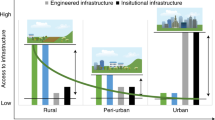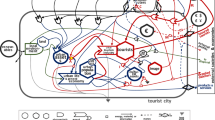Abstract
Main streets in city centers are struggling to stay afloat in the post-COVID era, as digital technologies continue to proliferate rapidly in retail. Here we examine the socioeconomic and spatial transformation of Jiang Han Road in Wuhan’s city center, aiming to understand the capacity of city-center main streets for fostering resilience and urban transition after the pandemic. Leveraging adaptive resilience and urban transformation theories with various qualitative and spatial data, we reveal two key features that suggest transformative resilience. First is a ‘regime shift’, exhibited by the focus of the retail landscape transitioning from the pedestrian/urban experience to a reinvented urban experience increasingly geared to socialization in the digital world. Second is a strong ‘adaptive capacity’, cocreated by multiscalar pedestrian mobility, shop mix, and complex ownership and control arrangements. Through such transformative resilience of city-center main streets, a digitized urban future with novel forms of reality and sense of place is emerging.
This is a preview of subscription content, access via your institution
Access options
Subscribe to this journal
Receive 12 digital issues and online access to articles
$119.00 per year
only $9.92 per issue
Buy this article
- Purchase on Springer Link
- Instant access to full article PDF
Prices may be subject to local taxes which are calculated during checkout






Similar content being viewed by others
Data availability
The base maps used for the spatial analysis were prepared by the authors, through extensive editing of the base maps manually drawn according to Baidu Maps and generated with a spatial dataset from Beijing City Lab in QGIS. The business establishment data (2016 and 2022) of the study area were originally from Amap.com, retrieved by two data crawling tools: LocoySpider and Octoparse. The above data are available from the corresponding author upon reasonable request.
References
Ford, L. America’s New Downtowns: Revitalization or Reinvention (Johns Hopkins Univ. Press, 2003).
Lowe, M. The regional shopping centre in the inner city: a study of retail-led urban regeneration. Urban Stud. 42, 449–470 (2005).
Amos, D. Understanding the legacy of pedestrian malls. J. Am. Plann. Assoc. 86, 11–24 (2020).
Gregg, K. Conceptualizing the pedestrian mall in post-war North America and understanding its transatlantic transfer through the work and influence of Victor Gruen. Plann. Perspect. 34, 551–577 (2019).
Southworth, M. Reinventing main street: from mall to townscape mall. J. Urban Des. 10, 151–170 (2005).
Rao, F. Resilient forms of shopping centers amid the rise of online retailing: towards the urban experience. Sustainability 11, 3999 (2019).
Cachinho, H. Consumerscapes and the resilience assessment of urban retail systems. Cities 36, 131–144 (2014).
Halibas, A. S., Van Nguyen, A. T., Akbari, M., Akram, U. & Hoang, M. D. T. Developing trends in showrooming, webrooming, and omnichannel shopping behaviors: Performance analysis, conceptual mapping, and future directions. J. Consum. Behav. 22, 1237–1264 (2023).
White, J. T. et al. Averting dead mall syndrome: de-malling and the future of the purpose-built shopping center in large UK cities. J. Urban Aff. https://doi.org/10.1080/07352166.2023.2239957 (2023).
Enoch, M. et al. When COVID-19 came to town: measuring the impact of the coronavirus pandemic on footfall on six high streets in England. Environ. Plann. B 49, 1091–1111 (2021).
Rao, F., Han, S. S. & Pan, R. Planning for resilient central-city shopping districts in the post-Covid era: an explanatory case study of the Hoddle Grid in Melbourne. Cambridge J. Reg. Econ. Soc. 15, 575–596 (2022).
Carmona, M. The existential crisis of traditional shopping streets: the sun model and the place attraction paradigm. J. Urban Des. 27, 1–35 (2022).
Helm, S., Kim, S. H. & Van Riper, S. Navigating the ‘retail apocalypse’: a framework of consumer evaluations of the new retail landscape. J. Retail. Consum. Serv. 54, 101683 (2020).
Beck, N. & Rygl, D. Categorization of multiple channel retailing in multi-, cross-, and omni‐channel retailing for retailers and retailing. J. Retail. Consum. Serv. 27, 170–178 (2015).
Bell, D. R., Gallino, S. & Moreno, A. How to win in an omnichannel world. MIT Sloan Manag. Rev. 56, 45–53 (2014).
Chatterjee, S., Chaudhuri, R. & Vrontis, D. Examining the global retail apocalypse during the COVID-19 pandemic using strategic omnichannel management: a consumers’ data privacy and data security perspective. J. Strat. Market. 29, 617–632 (2021).
Rao, F. & Liu, L. Toward urban-oriented shopping center development in the post-COVID era? Learning from shopping centers with Apple store. J. Plann. Educ. Res. https://doi.org/10.1177/0739456X231195335 (2023).
Wrigley, N. & Dolega, L. Resilience, fragility, and adaptation: new evidence on the performance of UK high streets during global economic crisis and its policy implications. Environ. Plann. A 43, 2337–2363 (2011).
Fernandes, J. & Chamusca, P. Urban policies, planning and retail resilience. Cities 36, 170–177 (2014).
Singleton, A. D., Dolega, L., Riddlesden, D. & Longley, P. A. Measuring the spatial vulnerability of retail centres to online consumption through a framework of e-resilience. Geoforum 69, 5–18 (2016).
Rao, F. & Summers, R. J. Planning for retail resilience: comparing Edmonton and Portland. Cities 58, 97–106 (2016).
Kärrholm, M., Nylund, K. & Prieto de la Fuente, P. Spatial resilience and urban planning: addressing the interdependence of urban retail areas. Cities 36, 121–130 (2014).
Hardaker, S., Appel, A. & Rauch, S. Reconsidering retailers’ resilience and the city: a mixed method case study. Cities 128, 103796 (2022).
Elmqvist, T. et al. Sustainability and resilience for transformation in the urban century. Nat. Sustain. 2, 267–273 (2019).
Simmie, J. & Martin, R. The economic resilience of regions: towards an evolutionary approach. Cambridge J. Reg. Econ. Soc. 3, 27–43 (2010).
Davoudi, S. et al. Resilience: a bridging concept or a dead end? Plann. Theory Pract. 13, 299–333 (2012).
Gunderson, L. H. & Holling, C. S. Panarchy: Understanding Transformations in Human and Natural Systems (Island Press, 2002).
Meerow, S., Newell, J. P. & Stults, M. Defining urban resilience: a review. Landscape Urban Plann. 147, 38–49 (2016).
Martin, R. Regional economic resilience, hysteresis and recessionary shocks. J. Econ. Geogr. 12, 1–32 (2012).
Elmqvist, T., Barnett, G. & Wilkinson, C. in Resilient Sustainable Cities: A Future (eds Pearson, L. J. et al.) 19–29 (Routledge, 2014).
Pelling, M. Adaptation to Climate Change: From Resilience to Transformation (Routledge, 2010).
Kates, R. W., Travis, W. R. & Wilbanks, T. J. Transformational adaptation when incremental adaptations to climate change are insufficient. Proc. Natl Acad. Sci. USA 109, 7156–7161 (2012).
O’Brien, K. Global environmental change II: from adaptation to deliberate transformation. Prog. Hum. Geogr. 36, 667–676 (2012).
Egerer, M. et al. Urban change as an untapped opportunity for climate adaptation. npj Urban Sustain. 1, 22 (2021).
Krueger, E. H. et al. Governing sustainable transformations of urban social-ecological-technological systems. npj Urban Sustain. 2, 10 (2022).
Patterson, J., Soininen, N., Collier, M. & Raymond, C. M. Finding feasible action towards urban transformations. npj Urban Sustain. 1, 28 (2021).
Meerow, S. & Newell, J. P. Urban resilience for whom, what, when, where, and why? Urban Geogr. 40, 309–329 (2019).
Fainstein, S. S. Resilience and justice: planning for New York City. Urban Geogr. 39, 1268–1275 (2018).
Bonds, A. Refusing resilience: the racialization of risk and resilience. Urban Geogr. 39, 1285–1291 (2018).
McGreevy, M. & Wilson, L. The civic and neighbourhood commons as complex adaptive systems: the economic vitality of the centre. Plann. Theory 16, 169–185 (2016).
Zukin, S., Kasinitz, P. & Chen, X. Global Cities, Local Streets: Everyday Diversity from New York to Shanghai (Routledge, 2016).
Jacobs, J. The Death and Life of Great American Cities (Random House, 1961).
Patton, M. Q. Enhancing the quality and credibility of qualitative analysis. Health Serv. Res. 34, 1189–1208 (1999).
Denzin, N. K. The Research Act: A Theoretical Introduction to Sociological Methods (Transaction, 1970).
Giddens, A. What’s next? Covid-19 and the future world order. University of Oslo https://www.sum.uio.no/english/research/networks/arne-naess-programme/arne-naess-symposia/events/anthony-giddens-covid-19-and-the-future-world.of-order.html (17 September 2020).
Thrift, N. Lifeworld Inc and what to do about it. Environ. Plann. D 29, 5–26 (2011).
Annual Report on Shopping Centres in China (China Chain Store & Franchise Association, 2023); http://www.ccfa.org.cn/portal/cn/xiangxi.jsp?id=445119&type=33
Jewell, N. Shopping Malls and Public Space in Modern China (Ashgate, 2015).
National data portal: Monthly data; domestic commerce; online retail sales (1 USD = 7 CNY). National Bureau of Statistics of China https://data.stats.gov.cn/index.htm (2023).
China E-commerce Annual Report (Ministry of Commerce of China, 2013); http://opendata.mofcom.gov.cn/front/data/detail?id=B81C4D46AF081F881468B4E0E4830E20
Quarterly Retail E-Commerce Sales (US Census Bureau, 2023); https://www.census.gov/retail/ecommerce.html
Flyvbjerg, B. Five misunderstandings about case-study research. Qualit. Inq. 12, 219–245 (2006).
Bushman, B. Calling the coronavirus the ‘Chinese virus’ matters – research connects the label with racist bias. The Conversation https://theconversation.com/calling-the-coronavirus-the-chinese-virus-matters-research-connects-the-label-with-racist-bias-176437 (18 February 2022).
Han, S. S. & Wu, X. Wuhan. Cities 21, 349–362 (2004).
Booher, D. E. & Innes, J. E. Planning with Complexity: An Introduction to Collaborative Rationality for Public Policy (Taylor and Francis, 2010).
Innes, J. E. Planning through consensus building: a new view of the comprehensive planning ideal. J. Am. Plann. Assoc. 62, 460–472 (1996).
Han, Z., Long, Y., Wang, X. & Hou, J. Urban redevelopment at the block level: methodology and its application to all Chinese cities. Environ. Plann. B 47, 1725–1744 (2020).
Majic, I. & Pafka, E. AwaP-IC—an open-source GIS tool for measuring walkable access. Urban Sci. 3, 48 (2019).
Acknowledgements
This work was supported by a Humanities and Social Sciences Research Grant for Young Scholars from the Ministry of Education of China (21YJCZH121; F.R.), the National Natural Science Foundation of China (42301209; F.R.), the Shanghai Pujiang Program (23PJC061; F.R.) and the Bureau of Urban Planning and Natural Resources of Shanghai (Ghzy-2023-GX08; F.R.). The research network extending an ongoing collaboration between the University of Melbourne, Wuhan Design Consultation Group and Shanghai Jiao Tong University helped organize the research team and conduct the fieldwork.
Author information
Authors and Affiliations
Contributions
F.R. and H.Z. designed the research and collected the data. F.R., H.Z. and Y.K. performed the data analysis. D.L. and T.L. contributed to polishing the analytical results. F.R. and S.S.H. contributed to conceptualizing, writing and revising the manuscript.
Corresponding author
Ethics declarations
Competing interests
The authors declare no competing interests.
Peer review
Peer review information
Nature Cities thanks Renia Ehrenfeucht, Xiaohua Zhong and the other, anonymous, reviewer(s) for their contribution to the peer review of this work.
Additional information
Publisher’s note Springer Nature remains neutral with regard to jurisdictional claims in published maps and institutional affiliations.
Supplementary information
Supplementary Information
Supplementary Table 1.
Rights and permissions
Springer Nature or its licensor (e.g. a society or other partner) holds exclusive rights to this article under a publishing agreement with the author(s) or other rightsholder(s); author self-archiving of the accepted manuscript version of this article is solely governed by the terms of such publishing agreement and applicable law.
About this article
Cite this article
Rao, F., Zhao, H., Han, S.S. et al. Transformative resilience of Wuhan’s city-center main streets in the post-COVID era. Nat Cities 1, 378–389 (2024). https://doi.org/10.1038/s44284-024-00063-3
Received:
Accepted:
Published:
Issue Date:
DOI: https://doi.org/10.1038/s44284-024-00063-3



